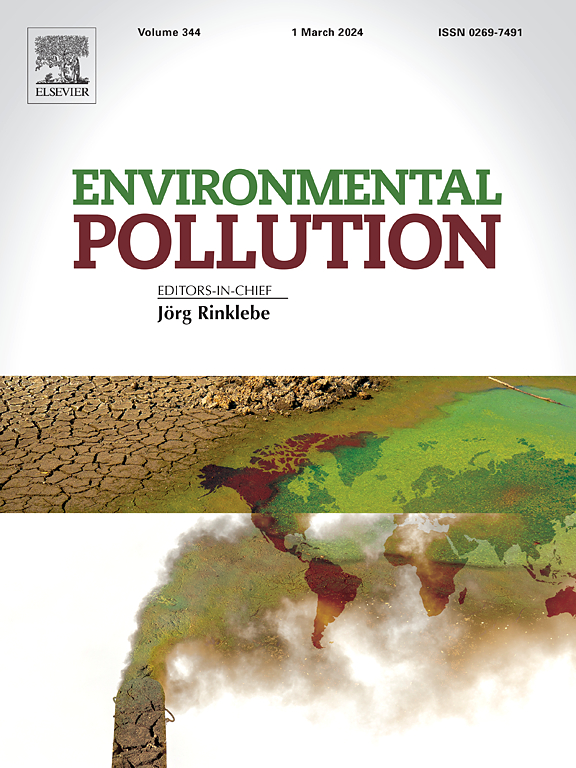Exposure to toxic metal(loid)s via breastmilk and stunting in infants living in the Lake Atitlán watershed, Guatemala
IF 7.6
2区 环境科学与生态学
Q1 ENVIRONMENTAL SCIENCES
引用次数: 0
Abstract
Guatemala has the highest child stunting prevalence in the Americas and is ranked sixth internationally. This paper examines concentrations of toxic metals and metalloids in the breastmilk of Mayan women in the Lake Atitlán watershed and explores potential relationships with stunting prevalence and demographic parameters to guide future research. We completed a cross-sectional study in 2022 (n = 80 mother/infant dyads) with 20 mother/infant dyads from each of four communities: San Juan La Laguna, San Pedro La Laguna, Panajachel, and Santiago Atitlán. We collected a breastmilk sample from each mother and measured the length of each infant (90–182 days old) to assess stunting (<-2 SD length-for-age below WHO growth standards median), and we collected community drinking water samples. The mean Z-score for stunting was −1.39 (SD = 1.24). Infants from Panajachel had a higher prevalence of stunting (x̅ = −2.06) than did infants from the other three communities. Metals and metalloids were quantified in breastmilk and water samples using inductively coupled plasma - mass spectrometry (ICP-MS). The concentrations of arsenic and lead in breastmilk were above the WHO safety standards in Panajachel and Santiago Atitlán, and concentrations of toxic metal(loid)s overall were highest in Panajachel. For infants from Panajachel and Santiago Atitlán, reduced Z-scores for stunting were associated with higher breastmilk concentrations of arsenic, barium, beryllium, and lead (p = 0.02–0.04). Water samples from these two communities exhibited greater concentrations of arsenic and barium than did water from other communities (p = 0.003–0.03). Significant associations between concentrations of arsenic, barium, beryllium, and lead with stunting score warrant a comprehensive assessment of the potential role of toxic metal(loid)s in child development. Stunting is a complex multifactorial problem; our results indicate that investigations of stunting should also evaluate exposures to toxic metal(loid)s in addition to the traditional causal factors such as malnutrition and chronic infections.


生活在危地马拉Atitlán湖流域的婴儿通过母乳接触有毒金属和发育迟缓
危地马拉是美洲儿童发育迟缓发生率最高的国家,在国际上排名第六。本文研究了Atitlán湖流域玛雅妇女母乳中有毒金属和类金属的浓度,并探讨了与发育迟缓患病率和人口参数的潜在关系,以指导未来的研究。我们于2022年完成了一项横断面研究(n=80对母亲/婴儿对),其中20对母亲/婴儿对来自四个社区:圣胡安拉古纳、圣佩德罗拉古纳、帕纳雅舍尔和圣地亚哥Atitlán。我们收集了每位母亲的母乳样本,并测量了每个婴儿(90-180日龄)的体长,以评估发育迟缓(年龄比标准差低于世卫组织生长标准中位数),我们还收集了社区饮用水样本。发育迟缓的平均z分数为-1.39 (SD = 1.24)。来自Panajachel的婴儿发育迟缓的患病率高于其他三个社区的婴儿(x= -2.06)。采用电感耦合等离子体质谱法(ICP-MS)对母乳和水样中的金属和类金属进行了定量分析。Panajachel和Santiago的母乳中砷和铅的浓度高于世卫组织安全标准Atitlán,有毒金属(loid)的总体浓度在Panajachel最高。对于来自Panajachel和Santiago Atitlán的婴儿,发育迟缓的z分数降低与母乳中砷、钡、铍和铅的浓度升高有关(p=0.02-0.04)。这两个社区的水样比其他社区的水样显示出更高的砷和钡浓度(p= 0.003-0.03)。砷、钡、铍和铅的浓度与发育迟缓评分之间存在显著关联,因此有必要对有毒金属在儿童发育中的潜在作用进行全面评估。发育迟缓是一个复杂的多因素问题;我们的研究结果表明,除了营养不良和慢性感染等传统的原因外,发育迟缓的调查还应评估有毒金属(样物质)的暴露。
本文章由计算机程序翻译,如有差异,请以英文原文为准。
求助全文
约1分钟内获得全文
求助全文
来源期刊

Environmental Pollution
环境科学-环境科学
CiteScore
16.00
自引率
6.70%
发文量
2082
审稿时长
2.9 months
期刊介绍:
Environmental Pollution is an international peer-reviewed journal that publishes high-quality research papers and review articles covering all aspects of environmental pollution and its impacts on ecosystems and human health.
Subject areas include, but are not limited to:
• Sources and occurrences of pollutants that are clearly defined and measured in environmental compartments, food and food-related items, and human bodies;
• Interlinks between contaminant exposure and biological, ecological, and human health effects, including those of climate change;
• Contaminants of emerging concerns (including but not limited to antibiotic resistant microorganisms or genes, microplastics/nanoplastics, electronic wastes, light, and noise) and/or their biological, ecological, or human health effects;
• Laboratory and field studies on the remediation/mitigation of environmental pollution via new techniques and with clear links to biological, ecological, or human health effects;
• Modeling of pollution processes, patterns, or trends that is of clear environmental and/or human health interest;
• New techniques that measure and examine environmental occurrences, transport, behavior, and effects of pollutants within the environment or the laboratory, provided that they can be clearly used to address problems within regional or global environmental compartments.
 求助内容:
求助内容: 应助结果提醒方式:
应助结果提醒方式:


